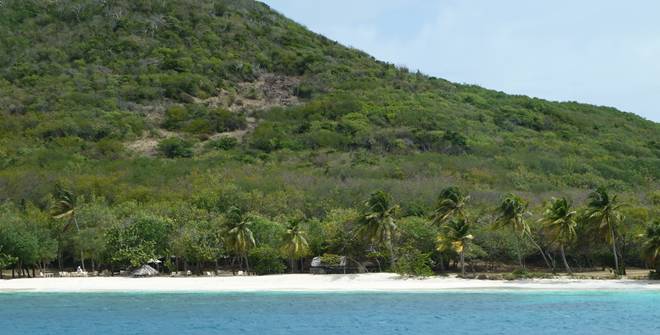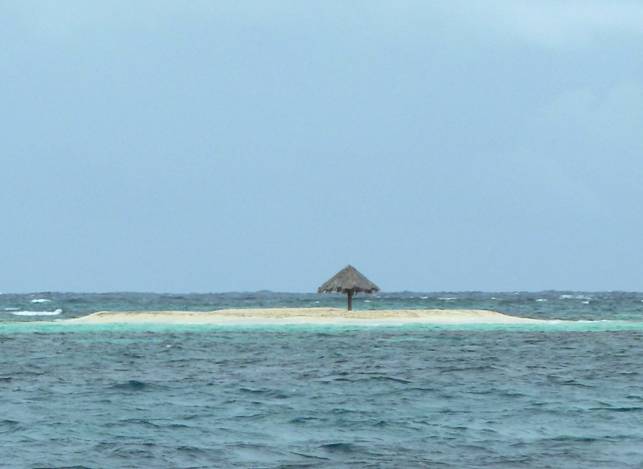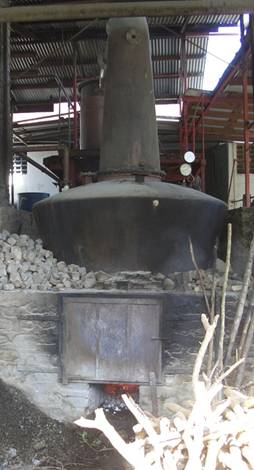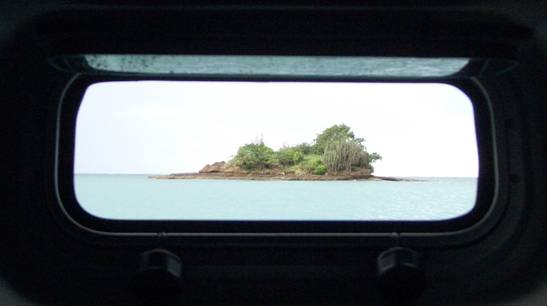Our interlude in the UK went by in a flash.
 |
| Well done, Peter! |
* * * * *
Back on board, we found it really hard to leave Le Phare Bleu. The ship was overwhelmed with tentacles of mangrove wrapping themselves around the ship and tying down our arms and legs too – in short, a very bad case of port rot indeed. But leave we eventually did, and dragging ourselves away, we sailed around the coast to St Georges. Fortuitously delayed here for 24 hrs by poor visibility from heavy rain, we were delighted by the arrival of the catamaran Saba, belonging to our German friends Daniel and Silkae, with their delightful daughters Lenna and Anna. We hadn't seen them since the Canaries, and it was good to hear all was well with them despite a catalogue of problems with their new, French built boat. Heading south, they are aiming for Panama and the Pacific, an adventurous enough trip even without two children under the age of 5!
The next day, sailing north in the lee of the island, we were pleased to cross paths with Paul on Stardust, an Oyster 56, on passage from Barbados to join the Oyster Regatta. We were sorry to miss this great social event, held in Grenada this year, but with such a late Atlantic crossing we needed to be further north if we were to see more of the Caribbean before the start of the hurricane season.
So onwards we sailed, pushing hard against the headwinds and west-going current towards Isle de Ronde. Our route took us close to Kick 'em Jenny, an active underwater volcano with a 1.5 km exclusion zone around it.
 |
| Diamond Island, near the underwater volcano |
The volcano last erupted in both 1988 and 1989, and it is thought the next eruption will form a new island. We anchored for lunch only 2 miles away at the uninhabited Isle de Ronde, and were much relieved that the volcano slumbered on. Apart from a pair of pelicans roosting in an old fishing boat nearby, we were the only occupants of the bay, and we enjoyed a good variety of corals and colourful tropical fish whilst snorkelling off the reefs at the head of the island, no doubt due to their remote location.
Our next stop was at Sandy Island, a tiny coral island with perfect white sand, though now with less vegetation since the hurricane Lenny. We anchored here for the night, and after a morning swim we made a long dinghy journey to Carriacou for provisions and customs clearance. This island is friendly, charming and relaxed. With far less development than its neighbour, it looks pretty much like the Grenada we remember from 32 years ago.
A short sail northwards again, and we anchor behind a reef at Petit St Vincent, a pretty island that is now an exclusive resort where the guests stay in remote stone cottages, each equipped with a flagpole to summon room service! The hotel was built by two ex-pilots from the US Air Force who sold up and sailed to the Caribbean in an old wooden yacht. They chartered, and it was one of their charter guests who thought it would be fun to buy an island and build a hotel. The hotel is still owned by the wife of one of the pilots.
 |
| Petit St Vincent |
The sail northwards from Petit St Vincent took us through a narrow pass in the reef between two tiny sand cays, Mopion ('crab louse') and Pinese ('bed bug'). No doubt these islands were more than a minor irritation to those unfortunate sailors who were wrecked on this shoal in the days before accurate satellite navigation.
 |
| Mopion. Not much to do here... |
The attractive anchorage at Clifton Harbour, Union Island, is tucked between two reefs, and is justifiably popular, especially with charter boats. With deteriorating weather, the wind and rain blew hard through the night. Thankfully our anchor, dug in hard against a rock, held fast. But our neighbours were not so fortunate. As the wind got up to a howl and the boats danced around each other, there was lots of shouting as a French Beneteau 43 with a crew of 3 older men struggled made several attempts to re anchor in the dark, their torches fading rapidly. By morning they had managed to moor up just behind us, but the skipper was still not happy. Despite the absence of his two crew members who had escaped ashore in the dinghy, the skipper decided he was going to have another go. The local 'boat boys', who offer their services - mooring buoys (sometimes dodgy deals), ice, collection of rubbish etc. - got involved, and one climbed aboard, so there was a lot more shouting especially as the skipper was motoring forward over the anchor chain and the boat boy who was supposed to be pulling up the anchor was busy on his mobile phone! The crew eventually did return to find their boat gone, and looking a little perplexed motored off in their dinghy to search the anchorage.
The following day, we sailed around the windward side of Union Island and past its short airstrip perched on an outcrop of rock. With hills to skirt on the landing approach, Stella and I mused over how difficult it must be for planes to land there. It was then that we noticed the remains of a small passenger plane at the side of the runway!
 |
| Happy landings, Union Island style. Safer by boat, I think... |
Onwards, up the lee of Mayreau, and then we sailed past the huge sailing cruise-liner Club Med 2 and into the Tobago cays, a marine national park set inside a protective reef.
 |
| Club Med 2 - a different kind of sailing experience! |
Anchored off Boradel island, the variety of marine life was amazing and swimming with green turtles in their natural habitat was just wonderful. The following morning, Walter, a local 'boat boy' (grandfather?) bought over some bread and a banana loaf from the mainland, freshly cooked by his wife. With 3000 miles of Atlantic Ocean stretching before us, it felt strange to be anchored with only a reef to protect us from the open sea!
Our next stop is a tiny deserted island called Petit Nevis. When we last called here on our first boat 'Coot' some 33 years ago, we found many huge old bones, remnants of the island's past history as a whaling station. Now it has been cleared up, but plans to develop the island have come to naught and it remains a peaceful place to hang out. The only other boat in the anchorage, the Canadian motor vessel 'Tasman', kindly offered us some fish. The blue marlin they had caught was over 8 feet long – rather a lot to eat on your own!
 |
| Petit Nevis |
Bequia still has an easy-going and yacht friendly atmosphere. Admiralty bay, a protected natural harbour, remains unspoilt and is a hive of activity. We're on a quest to find Noli Simmons, a friend from long ago, and we tie alongside a fishing boat to ask where he might be found.
The fishing boat has just arrived after 4 days at sea, and our conversation is interrupted by the crew blowing a conch shell 'horn' to announce their arrival! We buy some Dorado from their huge catch, which they fillet for us on the shore and rinse in the sea.
 |
| Com' buy me fish man! |
 |
| Noli - 32 years on |
As well as building and sailing traditional sailing yachts, Noli is a trained architect and built his own house too. He still lives on Bequia, building another house whilst researching local history. He remains a great fan of Isambard Kingdom Brunel.
 |
| Another lounge lizard at the Frangipani bar - this one is cannibalistic! |
It's only 14 miles to the next island, St Vincent, and we anchor in a tiny deserted bay called Petit Byahaut, which we initially have to ourselves. Just down the coast from the bay where 'Pirates of the Caribbean' was filmed, this bay is unspoilt with beautiful coral reefs which we dive on. We take a dinghy ride around the headland to a large and dark cave. I swim to the entrance, and inside I can see hundred of large bats flying around, the size of seagulls! There's a 30 foot long dark tunnel that apparently leads out through the cave into a rock fissure about 30 foot high and 40 foot deep, but it's just too spooky for me to attempt to swim through it. Chicken, or what?
 |
| Part of the film set for the film "Pirates of the Caribbean" in Wallilabou Bay, St Vincent, now sadly in disrepair. No sign of Johnny Depp. |
The sail to St Lucia was fast and comfortable with enough wind until we sailed into the lee of the Pitons – two mountains rising 2500 feet straight out of the sea. Here, the water was so deep that we picked up a mooring and tied the stern of our boat to a tree.
 |
| The Pitons, St Lucia. We moored at the base of Petit Piton, the one to the left of the picture. |
 |
| Just give us the banana and sod off... |











